Medical expert of the article
New publications
Preparations
Treatment of gastric ulcer and gastritis with antibiotics: scheme, list of drugs
Last reviewed: 04.07.2025

All iLive content is medically reviewed or fact checked to ensure as much factual accuracy as possible.
We have strict sourcing guidelines and only link to reputable media sites, academic research institutions and, whenever possible, medically peer reviewed studies. Note that the numbers in parentheses ([1], [2], etc.) are clickable links to these studies.
If you feel that any of our content is inaccurate, out-of-date, or otherwise questionable, please select it and press Ctrl + Enter.
A stomach ulcer, as well as gastritis, is considered a rather insidious pathology, since the causes that cause it are as varied as the consequences of the disease are dangerous if it is not treated. Probably, the most common cause of an ulcer in one or more sections of the gastrointestinal tract is a bacterial infection, and only small children do not know the name of the causative agent of the pathology. Only antimicrobial drugs will help protect the gastric mucosa from a bacterial attack. That is, antibiotics for stomach ulcers are not a whim of a doctor, but a harsh necessity.
When are antibiotics prescribed for stomach ulcers?
A stomach ulcer is a pathology that is in many ways similar to the popular gastritis, in which an inflammatory process, the presence of small lesions (erosive gastritis) and hemorrhages (hemorrhagic gastritis) can be observed on the organ's mucous membrane. Only in the case of an ulcerative lesion of the stomach, deeper wounds are found on its mucous membrane. Such lesions can be either single or multiple.
The cause of the development of a stomach ulcer can be both dysfunction of the secretory organs, due to which the acidity of the gastric juice increases significantly and irritates the mucous membrane of the main digestive organ, and some subjective reasons (poor nutrition, long-term use of hormonal and anti-inflammatory drugs, stress, frequent consumption of alcoholic beverages, smoking).
The doctor makes the diagnosis of "stomach ulcer" if the patient has the following symptoms: acute pain in the stomach (hunger, night pain, after eating), which quickly passes after taking antacids and analgesics, causeless feeling of hunger, nausea, vomiting (sometimes bloody), belching with a sour or metallic taste, a feeling of heaviness in the epigastrium, stool disorders. The presence of such symptoms allows the doctor to suspect a stomach ulcer, but it is possible to confirm the diagnosis and identify the cause of the pathology only after a special endoscopic examination of the stomach - fibrogastroduodenoscopy (FGDS).
Most often, an ulcer develops against the background of chronic gastritis with increased secretory function of the stomach. It is not characterized by an acute course. This is a chronic pathology with periods of exacerbation and remission.
Since gastric ulcers most often develop against the background of increased acidity of gastric juice, which is the optimal habitat and reproduction environment for the Helicobacter Pylori bacterium, it is this bacterium that is found in most patients.
It is simply impossible to determine by eye whether a pathology has a bacterial cause. This means that certain studies must be conducted before prescribing treatment, especially antibiotics for stomach ulcers. FGDS will help confirm or refute the presence of Helicobacter Pylori in the body, during which the doctor not only examines the inner surface of the stomach, but also measures the pH level of the gastric juice and analyzes for the bacterial pathogen. A test in exhaled air also helps to detect the presence of Helicobacter Pylori.
Indications for the use of antibiotics for gastric ulcers are the corresponding diagnosis and the presence of a bacterial infection in the body, confirmed by appropriate tests. If the gastric ulcer is not bacterial in nature, there is no point in prescribing antibiotics.
Such a disease as a stomach ulcer in its pure form is rare, usually the inflammatory-ulcerative process tends to spread deep into the body, capturing the initial sections of the intestine (the duodenum). Therefore, the diagnosis most often sounds like this - an ulcer of the stomach and 12-duodenum. Antibiotics for ulcers of the stomach and duodenum are prescribed for the same indications as for a stomach ulcer that has not spread to other organs.
The same antibiotics and treatment regimens with their use are prescribed for gastritis, because with their help it is necessary to fight the pathogen that is also found in stomach ulcers. Helicobacter Pylori can equally become both the cause of gastritis and a factor causing ulcerative processes in the gastrointestinal tract. It is this that makes the mucous membrane of the stomach and intestines more sensitive to the effects of various irritants, such as gastric juice.
Name and description of popular antibiotics for stomach ulcers
The traditional approach to the treatment of bacterial gastric ulcer involves the use of popular broad-spectrum antimicrobial drugs, which are used to treat not only gastrointestinal diseases, but also bacterial pathologies of the respiratory and genitourinary systems, skin infections, inflammatory diseases of the brain, etc.
In gastroenterology, it is customary to treat stomach ulcers with antibiotics of the following groups:
- semi-synthetic penicillins (mainly Amoxicillin),
- macrolides (preference is given to Clarithromycin, although Erythromycin is also found in some treatment regimens).
There are also popular treatment regimens for stomach ulcers and gastritis, where one of the antimicrobial drugs is a broad-spectrum antibiotic with antiprotozoal effect "Metronidazole".
Less commonly used are treatment regimens in which one of the antibiotics is "Tetracycline". They are used when other treatments have failed, as well as when the patient's body is intolerant to penicillins.
Let's take a closer look at what the above antibiotics used for stomach ulcers are, what their contraindications and side effects are.
Amoxicillin
A semi-synthetic antibacterial drug of the penicillin series with the active substance of the same name. It has a wide spectrum of antibacterial activity. Among the microorganisms sensitive to the drug's effects, there is also Helicobacter Pylori, popular in gastroenterology.
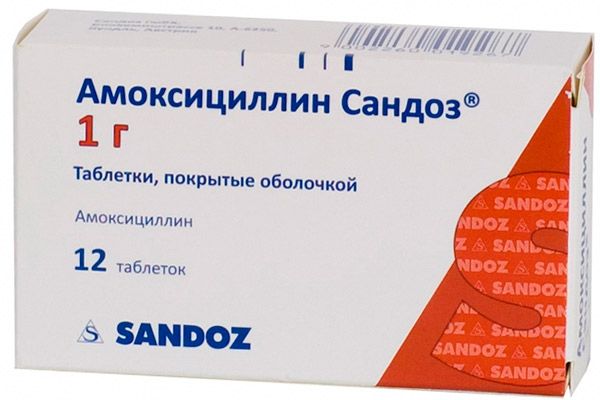
Release form. The pharmaceutical industry produces the drug in the form of tablets or capsules (250 and 500 mg), as well as granules, which are used to prepare a suspension. For the treatment of gastric ulcers, the antibiotic is prescribed in tablet form.
Pharmacodynamics. The drug is famous for its pronounced bactericidal action, i.e. it does not inhibit the process of reproduction of microorganisms, but destroys the cellular structure of the bacteria, which leads to its death.
Pharmacokinetics. The antibiotic is rapidly absorbed when taken orally, which is important for infectious diseases of the gastrointestinal tract, since this is how both local and systemic therapy of pathologies in which microorganisms are localized in the gastrointestinal tract is carried out. The maximum concentration of the active substance in the blood and liver can be determined 1-2 hours after taking the drug.
Food intake does not affect the absorption of the drug, and the acidic environment of the stomach is not able to destroy the active substance. The half-life of the antibiotic is approximately 1-1 ½ hours. It is excreted mainly in urine and feces.
Use during pregnancy. The active substance of the drug is able to penetrate the placenta to the fetus, therefore the use of the antibiotic during pregnancy is limited. It is prescribed if the bacterial pathology poses a danger to the life of the woman. The use of the drug during pregnancy did not show a pronounced negative effect of amoxicillin on the fetus.
It is not advisable to use the antibiotic during lactation, since it has the ability to penetrate into various body environments, including breast milk. During the period of treatment with the drug, the baby is transferred to artificial feeding.
Contraindications for use. The drug is not used if stomach ulcers and other infectious pathologies of the digestive organs are accompanied by frequent vomiting and diarrhea. In this case, you first need to remove the described symptoms, and then begin treatment.
Doctors do not prescribe this antibiotic for infectious mononucleosis, lymphocytic leukemia, respiratory diseases of viral etiology, hay fever, bronchial asthma. You cannot use a penicillin antibiotic in case of hypersensitivity to beta-lactam AMP (penicillins and cephalosporins) and allergic diathesis.
In some regimens, Amoxicillin is prescribed in combination with Metronidazole. This treatment regimen is unacceptable for diseases of the nervous system, hematopoiesis disorders, and negative reactions of the body to the use of nitroimidazole derivatives.
Side effects. Taking the antibiotic may be accompanied by such undesirable symptoms as an allergy to the drug in the form of skin rashes, runny nose, conjunctivitis, angioedema, joint pain. In case of penicillin intolerance, anaphylactic shock may rarely develop.
With reduced immunity, superinfections may develop. Long-term use of large doses of the drug may cause ataxia, dizziness, fainting, convulsions and other symptoms.
The simultaneous use of Amoxicillin and Metronidazole in some patients may cause nausea, vomiting, bowel disturbances, stomach pain, and stomatitis.
Overdose. Taking a large dose of antibiotics is usually accompanied by stomach upset and water-electrolyte imbalance. In kidney diseases, symptoms of nephrotoxicity may occur, sometimes salt crystals are found in the urine.
First aid: gastric lavage and administration of activated charcoal. Hemodialysis can be performed in a hospital setting.
Interaction with other drugs. Parallel administration of amoxicillin and bactericidal drugs enhances the therapeutic effect. Not used simultaneously with bacteriostatic antibiotics.
Diuretics and non-steroidal anti-inflammatory drugs, allopurinol, probenecid, and phenylbutazone can cause an increase in the concentration of amoxicillin in the blood.
Glucosamines, antacids, aminoglycosides, laxatives can negatively affect the absorption of the drug in the gastrointestinal tract. But ascorbic acid only promotes the effective absorption of amoxicillin.
Metronidazole enhances the activity of amoxicillin against Helicobacter Pylori.
Storage conditions. Store the drug at room temperature, protected from sun and moisture. Keep out of reach of children.
Shelf life. The drug retains its bactericidal properties for 3 years.
 [ 1 ], [ 2 ], [ 3 ], [ 4 ], [ 5 ], [ 6 ]
[ 1 ], [ 2 ], [ 3 ], [ 4 ], [ 5 ], [ 6 ]
Clarithromycin
A semi-synthetic antibiotic with a broad spectrum of antimicrobial activity from the macrolide group, which is considered the safest AMP due to the small number of side effects.
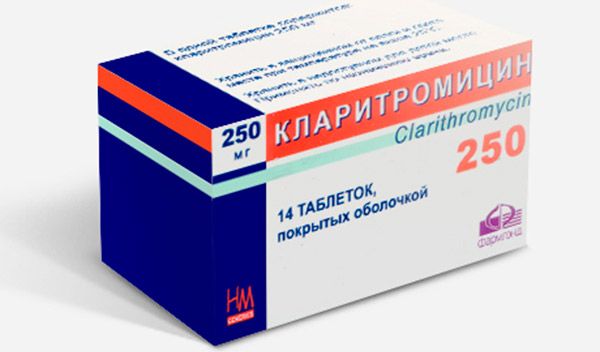
Release form. The drug can be found on pharmacy shelves in the form of 250 or 500 mg tablets.
Pharmacodynamics. The drug has a bactericidal effect on Helicobacter Pylori, since it inhibits the biosynthesis of protein, which is the main building material of the bacterial cell membrane.
Pharmacokinetics. Clarithromycin is a drug with nonlinear pharmacokinetics, which stabilizes within 2 days. It is taken regardless of food intake, which may slightly affect the rate of absorption. It is partially destroyed in the acidic environment of the stomach, so it is better to use it to treat ulcers that develop against the background of normal acidity.
The antibiotic creates sufficient concentrations in the gastric mucosa, which is facilitated by the simultaneous administration of the drug with Omeprazole.
Use during pregnancy. It is not recommended to use in the 1st trimester of pregnancy and during breastfeeding, since the effect of the drug on the fetus has not been sufficiently studied. In the 2nd and 3rd trimesters, it is prescribed for vital indications.
Contraindications for use. The drug is not prescribed to patients with ventricular arrhythmias and prolongation of the QT interval according to anamnesis data, hypokalemia, severe liver and kidney dysfunction, hypersensitivity to macrolide antibiotics and intolerance to some components of the drug.
Side effects. The drug is usually well tolerated by patients and does not cause negative symptoms. Less than 10% of patients may experience epigastric pain, nausea, dyspeptic symptoms, changes in taste perception, and insomnia.
Overdose. Taking large doses of the drug causes unpleasant symptoms from the gastrointestinal tract. Gastric lavage and symptomatic therapy are recommended.
Interaction with other drugs. It is unacceptable to use clarithromycin simultaneously with lovastatin and simvastatin.
Warfarin combined with clarithromycin may cause severe bleeding.
The use of the drug with antidiabetic agents often causes severe hypoglycemia, with aminoglycosides – toxic reactions.
Clarithromycin should not be taken concomitantly with cisapride, pimozide, astemizole, terfenadine, or ergot preparations.
Storage conditions. It is recommended to store the antibiotic at a temperature of up to 30 ° C, protecting it from sunlight and moisture. Keep out of reach of children.
Expiry date. The drug retains its properties for 2 years, after which it can no longer be taken.
 [ 7 ], [ 8 ], [ 9 ], [ 10 ], [ 11 ]
[ 7 ], [ 8 ], [ 9 ], [ 10 ], [ 11 ]
Metronidazole
A broad-spectrum antibiotic with antimicrobial activity and antiprotozoal properties. Its active ingredient is an imidazole derivative.
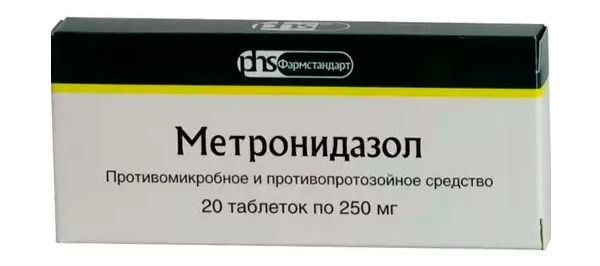
Release form. The drug is sold in the form of 250 mg tablets.
Pharmacodynamics. It has a destructive effect on the DNA of the bacterial molecular cell.
Pharmacokinetics. Like the previous drugs, it is rapidly absorbed in the gastrointestinal tract. It easily penetrates into various body environments, where it reaches therapeutic concentrations. It is excreted in urine and feces.
Use during pregnancy. According to animal studies, metronidazole is not capable of causing fetal malformations, although it penetrates the placenta, but due to the lack of similar studies on the human body, the drug is prescribed during pregnancy only if there are indications associated with a risk to the woman's life.
Breastfeeding should be discontinued during therapy with the drug.
Contraindications for use. The drug is not prescribed in case of hypersensitivity to its components. In pediatrics, it is used from the age of 6.
Side effects. Taking the drug may be accompanied by unpleasant symptoms of indigestion, reversible pancreatitis, hot flashes, skin rashes and itching, allergic and anaphylactic reactions. Sometimes patients complain of headaches, convulsions, dizziness, confusion, visual impairment, hallucinations, which requires discontinuing the antibiotic. There may be minor changes in blood tests.
Urine takes on a reddish-brown color, which is due to the peculiarities of drug metabolism.
Overdose. Taking a large dose of the drug may cause vomiting and disorientation. Treatment is symptomatic.
Interaction with other drugs. Metronidazole is not allowed to be combined with disulfiram and busulfan, which can lead to dangerous consequences. The antibiotic is incompatible with alcohol and drugs containing alcohol.
Metronidazole and drugs such as rifampicin and fluorouracil should be taken with caution. Concomitant use of the antibiotic and lithium preparations can cause toxic effects.
Storage conditions. Store the antibiotic at room temperature in a dark, dry place. Keep out of reach of children.
Shelf life. The drug retains its properties for 2 years.
Tetracycline
A broad-spectrum antibiotic with a bacteriostatic effect that inhibits the proliferation of bacteria, due to which their number gradually decreases.
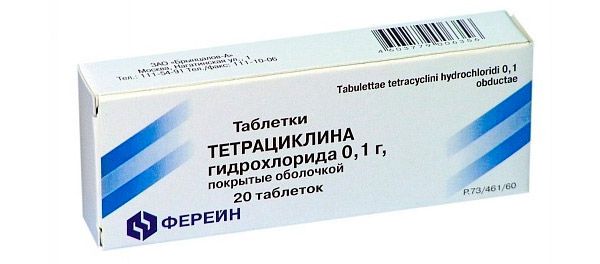
Pharmacokinetics. The half-life of the drug is 8 hours. It is excreted in urine and feces, and can be reabsorbed in the intestine.
Use during pregnancy. NOT used in the treatment of pregnant and lactating women.
Contraindications for use. The drug is not prescribed for fungal infections, severe liver and kidney pathologies, lupus erythematosus, leukopenia, hypersensitivity to tetracyclines. In pediatrics, it is used from 8 years of age.
Side effects. The most common side effects are nausea, stomach pain, diarrhea, dizziness, allergic reactions of varying severity, increased photosensitivity, symptoms of vitamin B deficiency, development of secondary fungal infections associated with disruption of the body's microflora.
Overdose. Manifested as increased side effects, appearance of foreign elements in urine. Treatment is symptomatic.
Interaction with other drugs. Simultaneous use with vitamin A preparations may cause an increase in intracranial pressure.
It is not advisable to use it simultaneously with bactericidal antibiotics.
Metal-containing drugs, antacids, cholestyramine, colestipol impair the absorption of tetracycline.
Storage conditions. Store the drug at room temperature, protected from sun and moisture. Keep out of reach of children.
Shelf life. Retains its properties for 3 years.
For irradiation of Helicobacter Pylori, all the above antibiotics are very rarely used as monotherapy. Usually, for this purpose, they are prescribed in accordance with one of the gastric ulcer treatment regimens, which includes 3 or more drugs.
Innovative drugs for the treatment of gastric ulcers
So, the classic approach to treating gastric ulcers caused by the bacterium Helicobacter Pylori involves a combination of 2 broad-spectrum antibiotics and additional drugs that protect the gastrointestinal mucosa and potentiate the action of antimicrobial agents. Thus, the patient has to take 2 to 4 tablets at a time, buying several drugs at once.
The modern pharmaceutical industry has made a step forward and developed drugs that combine the action of several drugs. Among the innovative antibacterial agents, you can find both combination drugs (Pylobact Neo and Helicocin) and bismuth drugs (the popular De-Nol).
The very name of the combination drugs speaks of their purpose. The indication for the use of these AMPs is the need for irradiation (destruction) of Helicobacter Pylori. Antibiotics are prescribed for gastric ulcer and duodenal ulcer, gastritis and duodenitis associated with bacterial infection.
Pylobact Neo
The composition of this drug is as close as possible to one of the treatment regimens for bacterial gastric ulcer: amoxicillin + clarithromycin + omeprazole. The drug is essentially a combination of drugs needed to combat Helicobacter Pylori. It is used as a monotherapy.
Release form. The package of the drug contains tablets of 2 antibiotics and capsules of omeprazole in the amount required for the course of treatment (7 days). The package contains 7 blisters. Each blister includes 2 tablets of amoxicillin and clarithromycin and 2 capsules of omeprazole.
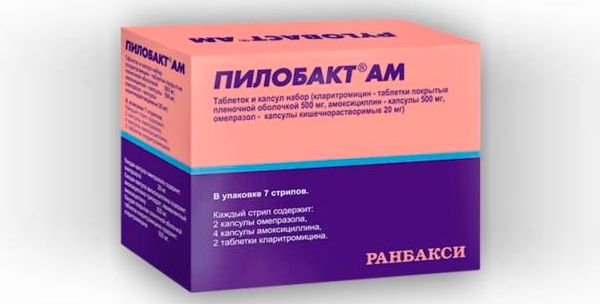
Pharmacodynamics. Antibiotics have a complex bactericidal effect on the pathogen, and the proton pump inhibitor omeprazole reduces the volume and acidity of gastric juice, promotes an increase in the concentration of AMP in the gastrointestinal mucosa, which makes irradiation therapy more effective without increasing the dose of antibiotics.
Use during pregnancy. The drug is not allowed to be taken during pregnancy and lactation.
Contraindications for use. The drug is not prescribed for hypersensitivity to any of its components, infectious mononucleosis, pathological changes in the blood, oncological pathologies. Intended for the treatment of patients over 16 years of age.
Side effects. The combined drug is quite well tolerated. Unpleasant symptoms characteristic of each component of the complex are mild and reversible. The inclusion of omeprazole in the drug may cause increased photosensitivity, slight hair loss, muscle weakness, pain in muscles and joints.
Method of administration and dosage. The course of treatment with the drug is designed for 7 days. The drug is taken 2 times a day: in the morning and in the evening in equal doses (1 tablet of amoxicillin and clarithromycin and 1 capsule of omeprazole). One blister is designed for 1 day of the therapeutic course.
Tablets and capsules should not be chewed, but swallowed with water.
Overdose. If you adhere to the recommended treatment regimen and dosage, overdose does not occur. Otherwise, symptoms of gastrointestinal disorders, headache and dizziness, confusion, allergic reactions may appear.
Storage conditions. The best conditions for storing the combined drug are considered to be a dry and dark room with a temperature of up to 25 o C.
Expiry date. The drug can be used without harm to health for 2 years.
An analogue of the above-described drug is considered to be "Ornistat" (composition: proton pump inhibitor rabeprazole sodium, antibiotics: ornidazole and clarithromycin).
Helicocin
A combination drug based on amoxicillin and metronidazole. It is used as part of a complex therapy for gastric ulcers, gastritis and duodenitis caused by bacterial infection.
Release form. The drug packaging contains blisters with 2 types of tablets: oval - metronidazole 500 mg, and round - amoxicillin 750 mg.

Pharmacodynamics. Antibiotics in the drug mutually enhance each other's bactericidal action, prevent the development of antibiotic resistance to the drug, and prevent relapses of gastric ulcers.
Pharmacokinetics. The drug is quickly absorbed in the gastrointestinal tract, its maximum concentration in the blood is observed 1-2 hours after administration. It is excreted in urine and feces.
Use during pregnancy. The use of the drug is permitted only for vital indications after assessing all risks.
Contraindications for use. The drug is not prescribed in case of individual intolerance to any of the components of the drug. Other contraindications can be found by reading the relevant section of the instructions for "Amoxicillin" and "Metronidazole".
Not used in pediatrics.
Side effects. If the doctor's instructions are followed, no side effects are observed. Possible side effects: loss of appetite, nausea and vomiting, diarrhea, metallic taste in the mouth, change in urine color, headaches, allergic reactions.
Method of administration and dosage. In the absence of liver and kidney pathologies, the drug is prescribed 2-3 times a day. A single dose includes one round and one oval tablet. In case of liver or kidney dysfunction, the antibiotic is taken no more than 2 times a day.
Overdose. Occurs when the recommended dose of the drug is exceeded. It manifests itself in the form of nausea and vomiting, dizziness, migraine-like pain, drowsiness or insomnia, weakness.
Storage conditions. It is recommended to store the combined antibiotic in a cool room (air temperature should not be higher than 25 o C), away from sunlight and moisture. Keep out of reach of children.
Expiry date: Use within 4 years from the production date indicated on the package.
De-Nol
A well-publicized drug with good advertising, claiming that it is the best remedy for fighting Helicobacter Pylori. In fact, the drug is not classified as an antibiotic, but as an antacid and absorbent.
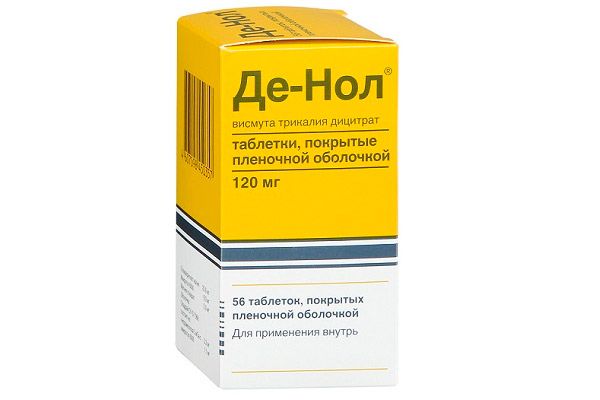
Release form. The drug is available in the form of tablets with engraving and a slight smell of ammonia. They are sealed in blisters of 8 pieces. The drug package may contain 7 or 14 blisters.
Pharmacodynamics. The antimicrobial properties of the drug are due to its active substance - bismuth subcitrate. Doctors have long noted the positive properties of bismuth-containing drugs in the treatment of inflammatory gastrointestinal diseases, because these drugs, in addition to protecting the mucous membrane, also have a bactericidal effect on the popular Helicobacter Pylori.
In addition to bactericidal, the drug is also credited with a pronounced antiulcer (enveloping, astringent) and gastroprotective effect. On the surface of the gastric mucosa, it forms a special film that does not allow the acid in the gastric juice to affect inflamed tissues and ulcers, which thus get the opportunity to heal faster.
The gastroprotective effect of bismuth is associated with the stimulation of the production of prostaglandin E2 in the body, which improves microcirculation in the tissues of the stomach and duodenum, reducing the level of hydrochloric acid and the activity of pepsin, which are irritating factors for the sensitive gastric mucosa weakened by a bacterial infection.
Pharmacokinetics. The active substance is practically not absorbed in the gastrointestinal tract. Only a small part of it gets into the blood. Nevertheless, even local antibacterial action, according to the instructions, has a very good effect, since no strain of Helicobacter Pylori has yet been found to develop resistance to bismuth subcitrate.
With prolonged use of the drug, bismuth subcitrate can accumulate in the blood plasma and its antibacterial effect is enhanced. The drug is excreted mainly with feces.
Use during pregnancy. Medicines based on bismuth compounds are not intended for the treatment of women during pregnancy and breastfeeding.
Contraindications for use. There are relatively few of them. The drug should not be prescribed in case of hypersensitivity to any component of the drug, as well as in case of severe renal failure.
In pediatrics, the drug is used to treat young patients aged 4 years and older.
Side effects. Negative symptoms during the medication intake are mainly limited to reactions from the gastrointestinal tract. This is nausea, sometimes accompanied by vomiting, stool disorders (constipation or diarrhea). Such symptoms are temporary and do not pose a danger, as well as rare allergic reactions (mostly mild in the form of skin rash and itching).
The accumulation of bismuth in the blood during long-term therapy in large doses is fraught with damage to the nervous system with the development of encephalopathy, since it is delivered with the blood to the central nervous system, where it partially settles.
Method of administration and dosage. The daily dose for the treatment of patients over 12 years of age is 480 mg (4 tablets). They can be taken one at a time 4 times a day or the daily dose can be divided equally into 2 doses.
The pediatric dose is within 1-2 tablets. The effective daily dosage is calculated using the formula: 8 mg of the drug for each kilogram of the patient's body weight.
Take the medicine before meals, with clean water or weak tea. You can eat half an hour after taking the medicine.
Overdose. Taking large doses of bismuth subcitrate can lead to renal failure and CNS dysfunction.
Treatment consists of gastric lavage, activated charcoal and saline laxatives. Blood purification by hemodialysis is effective.
Interaction with other drugs. The drug can reduce the absorption of tetracyclines. Antacids, fruits and dairy products reduce the effectiveness of the drug. Therefore, they can be used at an interval of half an hour before or after taking the tablets.
Storage conditions. Like many other drugs for Helicobacter Pylori irradiation, De-Nol is recommended to be stored in a dry, darkened room with an air temperature of 15-25 o C. Keep out of reach of children.
Expiry date. Use within 4 years. The production date and expiration date are indicated on the packaging and in the annotation to the medicine.
The advertisement of the drug does not provide complete information regarding the use of the drug, which makes it possible to assume that "De-Nol" is able to cope with the irradiation of Helicobacter Pylori on its own. Hence the many negative reviews, allegedly the drug is ineffective, and the advertisement is aimed at "pumping out" money.
In fact, the manufacturers themselves recommend using De-Nol to combat Helicobacter Pylori as part of complex therapy (specially developed multi-component antibiotic therapy regimens), where bismuth subcitrate acts as an antacid, an antibacterial component and a substance that reduces resistance to basic antibiotics, such as Metronidazole.
Method of administration and dosage of antibiotics for gastric ulcer
In gastroenterology, three- and four-component antibiotic therapy regimens are commonly used to treat pathologies caused by bacterial infection, including gastric ulcers associated with Helicobacter Pylori. These regimens usually include 1-2 antibiotics and additional components that regulate stomach acidity.
Let's look at the most popular treatment regimens for stomach ulcers.
2-component regimens with a 14-day course of treatment
- "Omeprazole" + "Amoxicillin". Omeprazole is taken in a dosage of 20-40 mg, amoxicillin - 750 mg. Frequency of administration - 2 times a day.
- "Omeprazole" + "Clarithromycin". Omeprazole is taken in a dosage of 40 mg in the morning, clarithromycin - 500 mg three times a day.
- "Omeprazole" + "Amoxicillin". Omeprazole is taken as in the previous scheme, amoxicillin - from 750 to 1500 mg twice a day.
The classic 3-component treatment regimen for gastric ulcers includes such drugs as an antibiotic (clarithromycin, amoxicillin, metronidazole), an antisecretory drug (omeprazole, pantoprazole, etc.) and a histamine H2-receptor blocker ( ranitidine, pyloride, etc.). However, such regimens have recently lost some of their popularity due to the emergence of new resistant strains of Helicobacter Pylori. To solve the problem of antibiotic resistance, it was customary to use 2 antibiotics in regimens simultaneously.
3-component regimens with a 10-day course of treatment
- "Clarithromycin" + "Metronidazole" + "Ranitidine". The drugs are taken twice a day in a single dose of 250, 400 and 150 mg.
- "Tetracycline" + "Metronidazole" + "Pylorid". The drugs are prescribed in dosages of 250, 400 and 400 mg, respectively. The frequency of administration is 2 times a day.
- "Amoxicillin" + "Metronidazole" + "Omeprazole". Omeprazole is taken at a dosage of 40 mg in the morning, amoxicillin at a dosage of 500 mg and metronidazole - 400 mg three times a day.
An example of a 3-component regimen with a weekly course of therapy:
- "Amoxicillin" + "Clarithromycin" + "Nexium". The drugs are prescribed in a single dose of 1000, 500 and 20 mg, respectively. The frequency of taking the drugs is 2 times a day.
4-component regimens with a 7-day course of treatment
- "Metronidazole" + "Tetracycline" + "Omeprazole" + "De-Nol". Single doses of the drugs are 250, 500, 20 and 120 mg, respectively. The first 2 drugs are taken 4 times a day, omeprazole - 2 times a day, "De-Nol" - every 4 hours (4-5 times a day).
- "Metronidazole" + "Tetracycline" + "Novobismol" + "Ranitidine". Single doses of the drugs are 250, 200, 120 and 300 mg, respectively. Ranitidine is taken 2 times a day, the other drugs - 5 times a day.
An example of a 4-component scheme with a 10-day course:
- "Metronidazole" + "Amoxicillin" + "Omeprazole" + "De-Nol". Single doses of the drugs are 250, 500, 20 and 120 mg, respectively. Omeprazole is taken 2 times a day, the other drugs - 3 times a day.
As a rule, one of the components of 4-component treatment regimens is bismuth preparations (bismuth subcitrate or subsalicylate). The selection of effective treatment regimens should be done by a specialist doctor, based on the patient's condition, the severity of the disease, and the individual and age characteristics of the patient's body.
Let's consider possible antibiotic regimens for stomach ulcers:
- "De-Nol" + "Metronidazole" + "Flemoxin". Bismuth subcitrate is taken in a dosage of 240 mg 2 times a day for a month, antibiotics in a dosage of 400 and 500 mg 3 times a day for a week.
- "De-Nol" + "Metronidazole" + "Tetracycline". Bismuth subcitrate is taken in a dosage of 120 mg, antibiotics are taken in a dosage of 400 and 500 mg, respectively. The frequency of taking the complex is 4 times a day. The course of treatment is 1 week.
- "De-Nol" + "Metronidazole" + "Clarithromycin". Bismuth subcitrate is taken in a dosage of 240 mg, antibiotics in a dosage of 400 and 250 mg. The frequency of taking the complex is 2 times a day. The course of treatment is 10 days.
- "De-Nol" + "Flemoxin" + "Clarithromycin". Bismuth subcitrate is taken in a dosage of 240 mg, antibiotics, respectively - 1000 and 250 mg. The frequency of taking the complex is 2 times a day, the course of treatment is 7 days.
- "De-Nol" + "Clarithromycin" + "Tetracycline". The dosage of the drugs is 120, 250 and 250 mg, respectively. The frequency of taking the complex is 4 times a day. The course of treatment is 10 days.
- "De-Nol" + "Flemoxin" + "Omeprazole". The dosage of the drugs is 120, 500 and 20 mg, respectively. Omeprazole is taken 2 times a day, antibacterial drugs - 4 times a day. The course of treatment is 14 days.
- "De-Nol" + "Clarithromycin" + "Omeprazole". Bismuth subcitrate in a dosage of 120 mg is taken 4 times a day, antibiotic and omeprazole in a dosage of 500 and 40 mg, respectively - 2 times a day. The course of treatment is 7 days.
There are also effective regimens with Furazolidone (an antimicrobial and antiprotozoal agent, a nitrofuran derivative), which also helps solve the problem of antibiotic resistance. The most popular regimen is:
"De-Nol" + "Amoxicillin" + "Furazolidone". Single doses of the drugs are 240, 500 and 100 mg, respectively. Bismuth subcitrate is taken 2 times a day, the remaining drugs - 4 times a day. The course of treatment is 14 days.
In this regimen, Ampicillin is sometimes replaced with Flemoxin Solutab or a drug from the group of protected penicillins.
Other recommended regimens with Furazolidone and bismuth subcitrate:
- "De-Nol" + "Furazolidone" + "Clarithromycin". Single doses of the drugs are 240, 100 and 250 mg, respectively.
- "De-Nol" + "Furazolidone" + "Tetracycline". Single doses of the drugs are 240, 200 and 750 mg, respectively.
In both regimens, all medications are taken twice a day. The course of treatment is 7 days.
All the above-described drugs help fight bacterial infection, which reduces the likelihood of gastric ulcer recurrence. However, to stabilize the patient's condition, antibiotic therapy should be combined with the intake of:
- antacids,
- histamine receptor blockers,
- proton pump inhibitors,
- gastrocytoprotectors,
- anticholinergics,
- ganglion blockers,
- antispasmodics,
- prokinetics,
- bismuth preparations.
Only a comprehensive approach to treating the stomach will give a positive result, while antibiotics for stomach ulcers will prevent relapses of the disease caused by the activity of Helicobacter Pylori.
Attention!
To simplify the perception of information, this instruction for use of the drug "Treatment of gastric ulcer and gastritis with antibiotics: scheme, list of drugs" translated and presented in a special form on the basis of the official instructions for medical use of the drug. Before use read the annotation that came directly to medicines.
Description provided for informational purposes and is not a guide to self-healing. The need for this drug, the purpose of the treatment regimen, methods and dose of the drug is determined solely by the attending physician. Self-medication is dangerous for your health.

